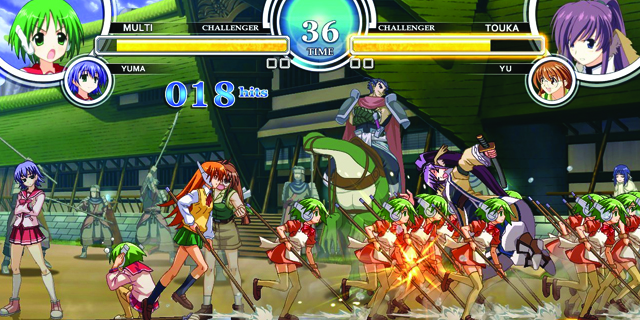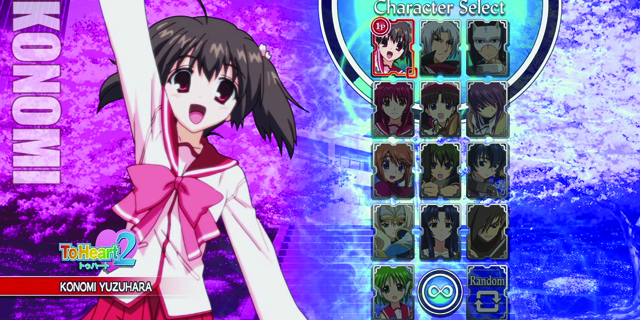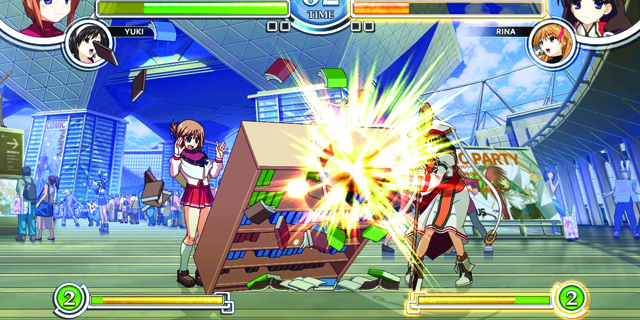
To some extent, fighters fall into a specific niche that only certain players can get into. When you dig deeper, that number gets even smaller, especially with anime fighters since, in general, knowledge of the source material is needed. If there were ever an award for most obscure source material, Aquapazza would win it easily. How does it hold up as a fighter when not many Westerners are familiar with the licensed characters and setting?
Aquapazza was developed by Examu (the company responsible for the Arcana Hearts series), and created as a collaborative effort between Aquaplus’ various teams. All the characters featured in-game are from a visual novel series developed by the company under its Leaf label: To Heart, Utawarerumono and Tears to Tiara. Unfortunately for us, the visual novels were never released here, so even brushing up on the source material by playing their games even proves to be a difficult task.
Anime fighters, in general, are known for their highly-detailed graphics, and Aquapazza doesn’t disappoint. The beautifully hand-drawn sprites stand out nicely against immensely-detailed backgrounds, rivaling those of King of Fighters XIII. A lot of love and effort was put into this game to let the Leaf fans appreciate it even more. The game only has Japanese voices as well, so be ready to do a lot of reading.

The game does have two story modes (one normal one, and an additional storyline unlocked upon the former mode’s completion) to cover some of that, but it doesn’t cover much about any of the cast. Story modes aside, the game features your typical fare: online, score attack, training and versus modes, most of which work as they should. The net code is fairly stable, so there isn’t much issue finding a match and playing it smoothly.
There’s also a ton of named game mechanics, like the Partner System, Splash Arts, Impact Guarding, Resist Smash and Active Emotion System, none of which the game elaborates on in any detail. About that last one: your emotions will run high when you take an aggressive approach, boosting your character’s attack power and ratcheting up even more when your health starts to dwindle. Taking a passive approach puts you in a low emotion, lowering your defense and making you more vulnerable to attacks. Emotions only last for a short amount of time, and even running in a low emotion, you have a chance to quickly recover and turn the tide.
The roster in Aquapazza totals 26 characters, with half comprising playable fighters and the rest there to assist. The characters themselves are fairly balanced, with each having a common play style (like ranged specialists, grapplers and rush-down fighters). If there’s a certain archetype you like, there’s a character that fits that mold. While each can definitely hold his or her own and deal tons of damage, the game gets a certain amount of depth from the assist system. Each assist pulls off a simple attack to help you in battle, helping to extend combo strings and inflict massive damage.

Unfortunately, the depth and precision necessary in Aquapazza makes it unfriendly to beginners. Since the game was balanced towards tournament play, you’re expected to have absolute control, and failure means losing the battle due to whiffed moves. Even in story mode, the AI will constantly be pulling off powerful combos, leaving you at a disadvantage almost instantly.
While the game’s appeal does lean very heavily toward anime fans, those looking for a good, interesting fighter to add to their collection shouldn’t skip out on Aquapazza. It’s a tight, balanced, tournament-ready fighter with enough interesting characters and charm to be a social centerpiece. With its budget price, it’s hard not to take a chance on this game, especially if you’re a fan of BlazBlue, Persona 4: Arena or Guilty Gear.
Pros: Fairly balanced, interesting source material, great music
Cons: (Really) obscure source material, very execution-heavy



















